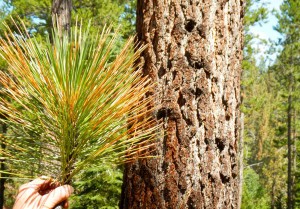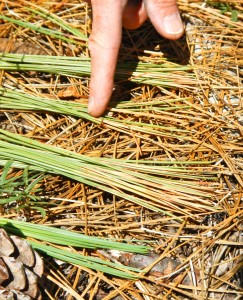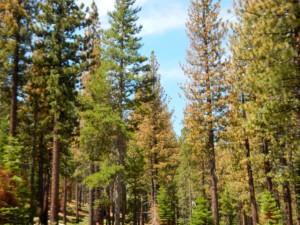By Katharine Mieszkowski, Center of Investigative Reporting
Gov. Jerry Brown has asked restaurants not to serve water unless diners ask for it. He’s letting lawns at the state Capitol turn brown. Farmers in the Central Valley are getting just a trickle of the water they usually do. Conspicuous water wasters – commercial and residential – face fines of $500 a day.
Even Lady Gaga is pleading with Californians to conserve.
All of California is in a state of emergency because of the prolonged drought, now in its third year. And it’s more than just Californians who are feeling the impact – the state uses its scarce water to provide the nation with more food than any other state.
Here’s a guide to what’s causing the drought and what it means for all of us.
Drought is part of life in California.
In the last century, the state suffered seven multiyear droughts.
This drought is particularly bad.
By this spring, California had experienced its driest three-year stretch since 1895.
San Francisco, Los Angeles, Sacramento and Fresno logged their driest year ever recorded in 2013.
California’s climate varies tremendously, from temperate rainforests on the North Coast to the extreme aridity of Death Valley. Conditions now are so dry that all of the state is considered to be in a drought. More than 80 percent of the state is in extreme or exceptional drought, according to the United States Drought Monitor.
An extreme drought happens once every 20 to 50 years and wreaks havoc on crops. An exceptional drought, meanwhile, comes every 50 to 100 years, causing true water emergencies by draining reservoirs, streams and wells.
Blame the severity of the drought on the “Ridiculously Resilient Ridge.”
That’s the cheeky nickname for a high-pressure area – think of it as a mountain of air – that sat for months over the eastern Pacific Ocean. The name was coined by Daniel Swain, a doctoral student at Stanford University who writes the California Weather Blog.
The ridge sent storms that normally would hit California up over the Alaskan panhandle and the Yukon, leaving California unusually dry. The ridge extended from British Columbia down the coast of California, blocking storms from making their way to the Golden State.
The state saw low rainfall last winter and during the latter part of the previous winter, which has left the already thirsty state parched.
Aside from being ridiculously resilient, the ridge is also a bit of a mystery. Such high-pressure areas commonly develop in the winter, but they usually break down, allowing storms to get to California. Climatologists don’t know why this ridge persisted so long.
Many farmers are getting walloped.
California farms, which guzzle 80 percent of the water used by humans in the state, are feeling the heat. Farmers in the dry Central Valley alone may stand to lose $810 million this year from keeping their fields idle, according to the UC Davis Center for Watershed Sciences. They’ll also spend an extra $453 million on pumping water out of the ground. The state likely will lose 17,100 agricultural jobs because of the drought.
California moves vast quantities of water around the state, but some of it just isn’t available this year. The Central Valley Project usually sends water from the northern half of the state to the dry San Joaquin Valley. Many farmers who depend on it are getting none of that water this year.
The State Water Project, which is a significant source of water for 750,000 acres of farmland, is delivering 5 percent of the water that farmers have requested.
About 428,000 acres, or 5 percent of the irrigated cropland in the Central Valley, Central Coast and Southern California, won’t be planted this year, researchers at UC Davis predict.
This has started to affect the price of fruits and vegetables in the United States.
California produces nearly half of the fruits, vegetables and nuts grown in the United States.
That means the drought already is starting to hit our pocketbooks as farmers idle land, driving up prices. The U.S. Department of Agriculture predicts fruit prices may rise as much as 6 percent this year, while vegetables may go up as much as 3 percent nationwide.
For instance, the majority of the nation’s lettuce is grown in California. Between April and May, prices for the leafy green went up 1.9 percent.
The popularity of almonds has only compounded the problem.
Some farmers in these areas have invested in lucrative crops that have to be watered year-round or they die.
In the past 20 years, nut trees, like almonds, have become more popular to plant because the crops are lucrative. In a dry year, a nut tree still needs water to survive, while an annual crop, like rice or tomatoes, could not be planted that year and the field left fallow.
Some farmers now are uprooting nut trees before they’re past their prime because they don’t have the water to keep them alive.
With water a scarcity, there’s a drilling frenzy to scoop up groundwater, causing the ground to sink in the Central Valley.
In some areas of the state, the groundwater has become so overtaxed that the earth is literally sinking. Between 2008 and 2011, parts of the Central Valley subsided more than 2 feet, as this startling visualization by NASA’s Jet Propulsion Laboratory shows.
Groundwater is an important source of water for the state in wet years and dry years, accounting for about 40 percent of water used in normal years and up to 60 percent in drought years, according to the California Water Foundation.
Some 75 percent of Californians rely on groundwater for at least a portion of their drinking water. Yet, California lacks a comprehensive groundwater management plan, which all other dry Western states already have.
Two bills in the Legislature right now seek to move the state toward local management of groundwater.
The drought is also causing fish evacuations and wildfires.
The ecologically important Sacramento-San Joaquin River Delta also is feeling the drought.
In June, rainbow trout and steelhead trout had to be released from two hatcheries at a much younger age and smaller size than usual. The reason: Scientists predicted that by midsummer, the water in the hatcheries would be too warm for the fish to survive, because there is so little mountain runoff. Chinook salmon have been trucked to San Pablo Bay so they won’t have to navigate parched rivers and streams on their way to the ocean.
Wildfire risk also is up statewide. This year, there had been 3,400 wildfires as of July 19, according to the California Department of Forestry and Fire Protection. That’s an increase of 36 percent over the five-year average.
In May, more than a dozen wildfires raged in San Diego County. The wildfire season there is usually in the fall following the hot, dry summer.
The state and federal governments have put hundreds of millions of dollars into aid.
In March, Brown signed drought relief legislation worth $687 million. It included $25.3 million for food and $21 million for housing for those like farmworkers who are out of work thanks to fallow fields. In February, President Barack Obama announced the federal government would chip in $183 million to the parched state.
When will the drought end?
When El Niño shows up, maybe.
That’s when warm waters develop in the Pacific Ocean, which often bring wet winters to California. The National Oceanic and Atmospheric Administration now puts the odds of El Niño at 80 percent.
But there’s a big catch.
California needs a strong El Niño to reliably deliver that rain. Right now, it’s shaping up to be weak or moderate.
In search of El Niño, meteorologists scrutinize current sea surface temperatures, air patterns and ocean currents around the globe, using computer models to analyze how all those factors interact.
They’re trying to forecast what the sea surface temperature will be for a large expanse of ocean along the equator south of Hawaii, known as the east-central Equatorial Pacific. If that water is warmer than usual for a solid three-month stretch, it’s El Niño – the warmer it is, the stronger the El Niño.
Get used to these droughts.
It’s difficult to link any one weather event – like the current drought – to climate change.
Whatever happens this winter, it is highly likely that Californians can expect even more extreme droughts in the future, thanks to climate change.
Southern California will get drier, climate scientists predict. Northern California will get hotter. Some snow won’t fall as snow anymore – it’d become rain. The snow that does fall will melt faster. That could shrink the Sierra Nevada spring snowpack by as much as 90 percent.
The loss of snow doesn’t affect just the annual family snowball fight. When the snowpack – often called California’s largest reservoir – melts in the spring, it is an essential source of water for farms and cities.
That means less water for all of us.



